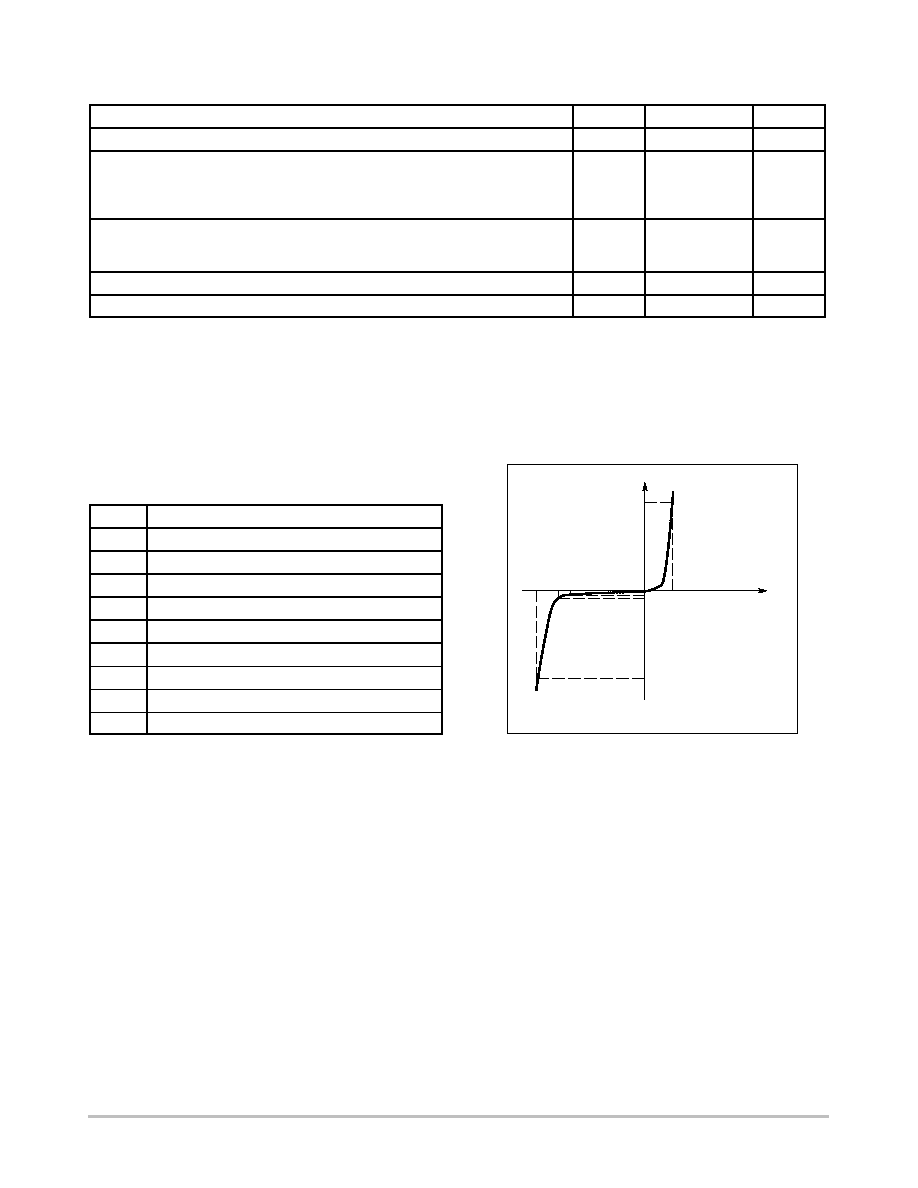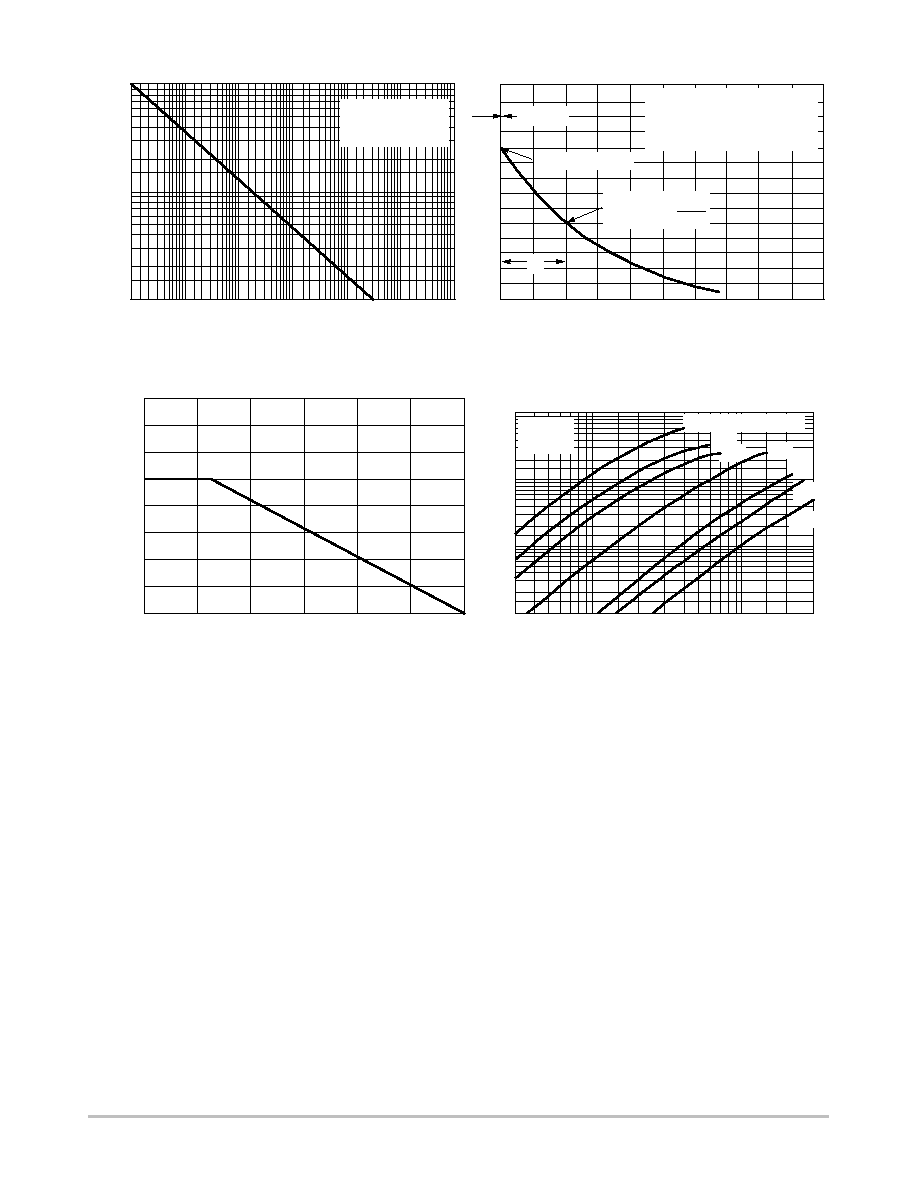
©
Semiconductor Components Industries, LLC, 2004
April, 2004 - Rev. 5
1
Publication Order Number:
1.5SMC6.8AT3/D
1.5SMC6.8AT3 Series
1500 Watt Peak Power
Zener Transient Voltage
Suppressors
Unidirectional*
The SMC series is designed to protect voltage sensitive
components from high voltage, high energy transients. They have
excellent clamping capability, high surge capability, low zener
impedance and fast response time. The SMC series is supplied in
ON Semiconductor's exclusive, cost-effective, highly reliable
Surmetic
TM
package and is ideally suited for use in communication
systems, automotive, numerical controls, process controls, medical
equipment, business machines, power supplies and many other
industrial/consumer applications.
Specification Features:
∑
Working Peak Reverse Voltage Range - 5.8 to 77.8 V
∑
Standard Zener Breakdown Voltage Range - 6.8 to 91 V
∑
Peak Power - 1500 Watts @ 1.0 ms
∑
ESD Rating of Class 3 (>16 kV) per Human Body Model
∑
Maximum Clamp Voltage @ Peak Pulse Current
∑
Low Leakage < 5.0
mA Above 10 V
∑
UL 497B for Isolated Loop Circuit Protection
∑
Maximum Temperature Coefficient Specified
∑
Response Time is Typically < 1.0 ns
∑
Pb-Free Packages are Available
Mechanical Characteristics:
CASE:
Void-free, transfer-molded, thermosetting plastic
FINISH:
All external surfaces are corrosion resistant and leads are
readily solderable
MAXIMUM CASE TEMPERATURE FOR SOLDERING PURPOSES:
260
∞
C for 10 Seconds
LEADS:
Modified L-Bend providing more contact area to bond pads
POLARITY:
Cathode indicated by molded polarity notch
MOUNTING POSITION:
Any
MAXIMUM RATINGS
Please See the Table on the Following Page
PLASTIC SURFACE MOUNT
ZENER OVERVOLTAGE
TRANSIENT SUPPRESSORS
5.8 - 78 VOLTS
1500 WATT PEAK POWER
Device**
Package
Shipping
ORDERING INFORMATION
1.5SMCxxxAT3
SMC
2500/Tape & Reel
SMC
CASE 403
PLASTIC
Cathode
Anode
Y
= Year
WW
= Work Week
xxxA
= Specific Device Code
=
(See Table on Page 3)
YWW
xxxA
MARKING DIAGRAM
*Bidirectional devices will not be available in this se-
ries.
**The "T3" suffix refers to a 13 inch reel.
http://onsemi.com
Individual devices are listed on page 3 of this data sheet.
For information on tape and reel specifications,
including part orientation and tape sizes, please
refer to our Tape and Reel Packaging Specifications
Brochure, BRD8011/D.
1.5SMCxxxAT3G
SMC
(Pb-Free)
2500/Tape & Reel

1.5SMC6.8AT3 Series
http://onsemi.com
2
MAXIMUM RATINGS
Rating
Symbol
Value
Unit
Peak Power Dissipation (Note 1) @ T
L
= 25
∞
C, Pulse Width = 1 ms
P
PK
1500
W
DC Power Dissipation @ T
L
= 75
∞
C
Measured Zero Lead Length (Note 2)
Derate Above 75
∞
C
Thermal Resistance from Junction-to-Lead
P
D
R
q
JL
4.0
54.6
18.3
W
mW/
∞
C
∞
C/W
DC Power Dissipation (Note 3) @ T
A
= 25
∞
C
Derate Above 25
∞
C
Thermal Resistance from Junction-to-Ambient
P
D
R
q
JA
0.75
6.1
165
W
mW/
∞
C
∞
C/W
Forward Surge Current (Note 4) @ T
A
= 25
∞
C
I
FSM
200
A
Operating and Storage Temperature Range
T
J
, T
stg
-65 to +150
∞
C
Maximum ratings are those values beyond which device damage can occur. Maximum ratings applied to the device are individual stress limit
values (not normal operating conditions) and are not valid simultaneously. If these limits are exceeded, device functional operation is not implied,
damage may occur and reliability may be affected.
1. 10 X 1000
m
s, non-repetitive
2. 1
square copper pad, FR-4 board
3. FR-4 board, using ON Semiconductor minimum recommended footprint, as shown in 403 case outline dimensions spec.
4. 1/2 sine wave (or equivalent square wave), PW = 8.3 ms, duty cycle = 4 pulses per minute maximum.
ELECTRICAL CHARACTERISTICS
(T
A
= 25
∞
C unless
otherwise noted, V
F
= 3.5 V Max. @ I
F
(Note 5) = 100 A)
Symbol
Parameter
I
PP
Maximum Reverse Peak Pulse Current
V
C
Clamping Voltage @ I
PP
V
RWM
Working Peak Reverse Voltage
I
R
Maximum Reverse Leakage Current @ V
RWM
V
BR
Breakdown Voltage @ I
T
I
T
Test Current
Q
V
BR
Maximum Temperature Coefficient of V
BR
I
F
Forward Current
V
F
Forward Voltage @ I
F
5. 1/2 sine wave or equivalent, PW = 8.3 ms
non-repetitive duty cycle
Uni-Directional TVS
I
PP
I
F
V
I
I
R
I
T
V
RWM
V
C
V
BR
V
F

1.5SMC6.8AT3 Series
http://onsemi.com
3
ELECTRICAL CHARACTERISTICS
(Devices listed in bold, italic are ON Semiconductor Preferred devices.)
V
RWM
Breakdown Voltage
V
C
@ I
PP
(Note 8)
Device
V
RWM
(Note 6)
I
R
@ V
RWM
V
BR
Volts (Note 7)
@ I
T
V
C
I
PP
Q
V
BR
Device
Device
Marking
Volts
m
A
Min
Nom
Max
mA
Volts
Amps
%/
∞
C
1.5SMC6.8AT3
1.5SMC7.5AT3
1.5SMC8.2AT3
1.5SMC9.1AT3
6V8A
7V5A
8V2A
9V1A
5.8
6.4
7.02
7.78
1000
500
200
50
6.45
7.13
7.79
8.65
6.8
7.5
8.2
9.1
7.14
7.88
8.61
9.55
10
10
10
1
10.5
11.3
12.1
13.4
143
132
124
112
0.057
0.061
0.065
0.068
1.5SMC10AT3
1.5SMC11AT3
1.5SMC12AT3
1.5SMC13AT3
10A
11A
12A
13A
8.55
9.4
10.2
11.1
10
5
5
5
9.5
10.5
11.4
12.4
10
11
12
13
10.5
11.6
12.6
13.7
1
1
1
1
14.5
15.6
16.7
18.2
103
96
90
82
0.073
0.075
0.078
0.081
1.5SMC15AT3
1.5SMC15AT3G
1.5SMC16AT3
1.5SMC18AT3
1.5SMC20AT3
15A
15A
16A
18A
20A
12.8
12.8
13.6
15.3
17.1
5
5
5
5
5
14.3
14.3
15.2
17.1
19
15
15
16
18
20
15.8
15.8
16.8
18.9
21
1
1
1
1
1
21.2
21.2
22.5
25.2
27.7
71
71
67
59.5
54
0.084
0.084
0.086
0.088
0.09
1.5SMC22AT3
1.5SMC24AT3
1.5SMC27AT3
1.5SMC30AT3
22A
24A
27A
30A
18.8
20.5
23.1
25.6
5
5
5
5
20.9
22.8
25.7
28.5
22
24
27
30
23.1
25.2
28.4
31.5
1
1
1
1
30.6
33.2
37.5
41.4
49
45
40
36
0.092
0.094
0.096
0.097
1.5SMC33AT3
1.5SMC36AT3
1.5SMC39AT3
1.5SMC43AT3
33A
36A
39A
43A
28.2
30.8
33.3
36.8
5
5
5
5
31.4
34.2
37.1
40.9
33
36
39
43
34.7
37.8
41
45.2
1
1
1
1
45.7
49.9
53.9
59.3
33
30
28
25.3
0.098
0.099
0.1
0.101
1.5SMC47AT3
1.5SMC51AT3
1.5SMC56AT3
1.5SMC62AT3
1.5SMC62AT3G
47A
51A
56A
62A
40.2
43.6
47.8
53
53
5
5
5
5
5
44.7
48.5
53.2
58.9
58.9
47
51
56
62
62
49.4
53.6
58.8
65.1
65.1
1
1
1
1
1
64.8
70.1
77
85
85
23.2
21.4
19.5
17.7
17.7
0.101
0.102
0.103
0.104
0.104
1.5SMC68AT3
1.5SMC75AT3
1.5SMC82AT3
1.5SMC91AT3
68A
75A
82A
91A
58.1
64.1
70.1
77.8
5
5
5
5
64.6
71.3
77.9
86.5
68
75
82
91
71.4
78.8
86.1
95.5
1
1
1
1
92
103
113
125
16.3
14.6
13.3
12
0.104
0.105
0.105
0.106
NOTE:
Devices listed in
bold, italic are ON Semiconductor Preferred devices. Preferred devices are recommended choices for future
use and best overall value.
* The "G" suffix indicates Pb-Free package available.
6. A transient suppressor is normally selected according to the working peak reverse voltage (V
RWM
), which should be equal to or greater than
the DC or continuous peak operating voltage level.
7. V
BR
measured at pulse test current I
T
at an ambient temperature of 25
∞
C.
8. Surge current waveform per Figure 2 and derate per Figure 3 of the General Data - 1500 Watt at the beginning of this group.

1.5SMC6.8AT3 Series
http://onsemi.com
4
NONREPETITIVE
PULSE WAVEFORM
SHOWN IN FIGURE 2
t
P
, PULSE WIDTH
1
10
100
0.1
ms 1
ms
10
ms
100
ms
1 ms
10 ms
Figure 1. Pulse Rating Curve
0
1
2
3
4
0
50
100
t, TIME (ms)
V
ALUE (%)
HALF VALUE - I
PP
2
PEAK VALUE - I
PP
Figure 2. Pulse Waveform
Figure 3. Pulse Derating Curve
PEAK PULSE DERA
TING IN % OF
PEAK POWER OR CURRENT
@
T A
= 25
C
∞
100
80
60
40
20
0
0
25
50
75
100
125
150
T
A
, AMBIENT TEMPERATURE (
∞
C)
120
140
160
t
P
PULSE WIDTH (t
P
) IS DEFINED
AS THAT POINT WHERE THE PEAK
CURRENT DECAYS TO 50%
OF I
PP
.
DV
BR
, INSTANTANEOUS INCREASE IN V
BR
ABOVE V
BR
(NOM) (VOLTS)
0.3
0.5 0.7 1
2
3
5
7 10
20 30
1000
500
200
100
50
1
2
5
10
20
T
L
= 25
∞
C
t
P
= 10 ms
V
BR
(NOM) = 6.8 TO 13 V
20 V
24 V
43 V
75 V
120 V
180 V
Figure 4. Dynamic Impedance
P
pk
, PEAK POWER (kW)
t
r
10 ms
I
T
, TEST CURRENT (AMPS)
UL RECOGNITION
The entire series has Underwriters Laboratory
Recognition for the classification of protectors (QVGV2)
under the UL standard for safety 497B and File #116110.
Many competitors only have one or two devices recognized
or have recognition in a non-protective category. Some
competitors have no recognition at all. With the UL497B
recognition, our parts successfully passed several tests
including Strike Voltage Breakdown test, Endurance
Conditioning, Temperature test, Dielectric Voltage-Withstand
test, Discharge test and several more.
Whereas, some competitors have only passed a
flammability test for the package material, we have been
recognized for much more to be included in their Protector
category.

1.5SMC6.8AT3 Series
http://onsemi.com
5
APPLICATION NOTES
RESPONSE TIME
In most applications, the transient suppressor device is
placed in parallel with the equipment or component to be
protected. In this situation, there is a time delay associated
with the capacitance of the device and an overshoot
condition associated with the inductance of the device and
the inductance of the connection method. The capacitive
effect is of minor importance in the parallel protection
scheme because it only produces a time delay in the
transition from the operating voltage to the clamp voltage as
shown in Figure 5.
The inductive effects in the device are due to actual
turn-on time (time required for the device to go from zero
current to full current) and lead inductance. This inductive
effect produces an overshoot in the voltage across the
equipment or component being protected as shown in
Figure 6. Minimizing this overshoot is very important in the
application, since the main purpose for adding a transient
suppressor is to clamp voltage spikes. The SMC series have
a very good response time, typically < 1.0 ns and negligible
inductance. However, external inductive effects could
produce unacceptable overshoot. Proper circuit layout,
minimum lead lengths and placing the suppressor device as
close as possible to the equipment or components to be
protected will minimize this overshoot.
Some input impedance represented by Z
in
is essential to
prevent overstress of the protection device. This impedance
should be as high as possible, without restricting the circuit
operation.
DUTY CYCLE DERATING
The data of Figure 1 applies for non-repetitive conditions
and at a lead temperature of 25
∞
C. If the duty cycle increases,
the peak power must be reduced as indicated by the curves
of Figure 7. Average power must be derated as the lead or
ambient temperature rises above 25
∞
C. The average power
derating curve normally given on data sheets may be
normalized and used for this purpose.
At first glance the derating curves of Figure 7 appear to be
in error as the 10 ms pulse has a higher derating factor than
the 10
ms pulse. However, when the derating factor for a
given pulse of Figure 7 is multiplied by the peak power value
of Figure 1 for the same pulse, the results follow the
expected trend.




